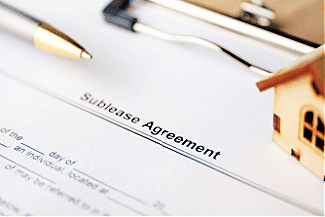Landlord Consent and Sublet Agreements

Renters should always ask for their landlord’s consent to sublease if they want to sublet their apartment. This consent may end up being conditioned on several factors, such as the proposed subtenant’s financial position and what they plan to do in the sublet location. In any event, when a subtenant will be moving in, a landlord’s consent to sublease form should be in place, along with a written sublease agreement between the tenant and the subtenant.
Lease vs. Sublease
First, it is important to distinguish between a lease, which is between a landlord and a tenant, and a sublease, which is between the tenant and a subtenant. As you can see, the parties to the two contracts are different, and yet the tenant is bound to terms in both.
To put it bluntly, the tenant is always responsible to pay rent to the landlord even if the subtenant fails to pay on time. The tenant also is responsible for any damage the subtenant causes to the unit. These facts make it clear that the tenant should perform solid screening when selecting a subtenant.
Landlord’s Consent to Sublease
While some landlords may default to providing a simple, one-line sentence offering their approval for a sublet, they may want to consider going into slightly more detail in order to protect their interests.
For example, a landlord may want to specify that the tenant remains liable for all of the aspects outlined in the original lease, that the subtenant may not further sublet the unit without the landlord’s consent, that the tenant and subtenant may not change the sublease without the landlord’s consent, and that the subtenant provide certain financial and liability insurance information to the landlord at their request.
Need a Lease Agreement?
Access 150+ state-specific legal landlord forms, including a lease.
How to Write a Sublet Agreement
Next on the agenda is having a sublet rental agreement drawn up so that the tenant’s and subtenant’s rights and obligations are written down and enforceable. While there is no single required sublet agreement format, generally a sublease contains the following information:
- Payment terms (amount, date)
- Length of sublease (month-to-month, yearly, etc.)
- Other rights and duties of each party
- Termination terms
Note that eviction terms are usually covered by state law, as opposed to being written into rental contracts.
Whether you’re a landlord, tenant, or subtenant, it’s a good idea to protect yourself with the proper legal documents concerning the sublet. In addition to the most obvious document—a sublease—you may also want to consider having the landlord’s consent conditions spelled out so that everyone understands the complete parameters of the sublet agreement.
You also may wish to consult with an attorney familiar with subleasing to ensure that you’re fully covering all of your rental bases.
Source: Legal Zoom















 Accessibility
Accessibility